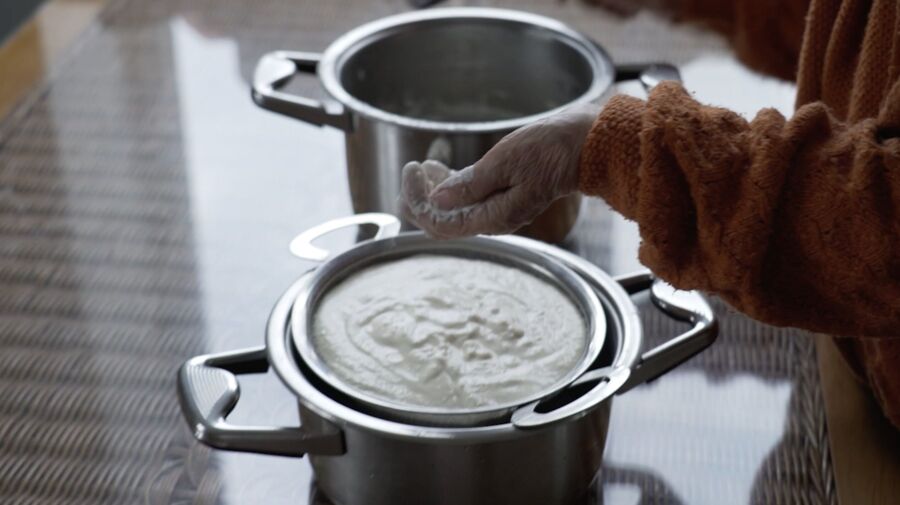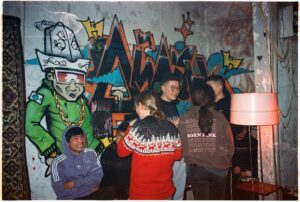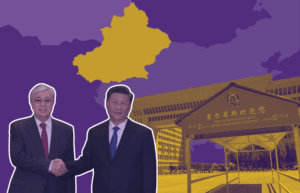We are continuing our series of articles on Kazakhstani documentaries revolutionizing everyday life. Documentary film directors and producers Kristina Mikhailova, Dana Sabitova and Almira Ismailova analyze Kazakhstani documentaries in cultural, social and industrial contexts. This time we will focus on the short film “Alaqan” directed by Aida Adilbek, looking at its relationship with decoloniality and genre transgression, and talk to Aida herself about the family documentary.
Kristina Mikhailova: Aida Adilbek represented Kazakhstan this year at the goEast Film Festival, which for 20 years has been one of the most important platforms for films from Central Asia and Eastern Europe. Aida curated a program of short films by DAVRA, a collective of Central Asian female cultural activists. This year the film festival also held a symposium on the decolonization of the (post)soviet screen, where Aida was a speaker on the panel “Post-, Neo-, and De-colonial Central Asia“. This is where we should start discussing the film “Alaqan,” as it was Aida Adilbek who represented Kazakhstan in the context of decolonial optics, which is important for Central Asia in the current political climate.
Whereas for many years in a row, film festivals have turned directly to national film studios in search of Central Asian films – Kazakhfilm, Uzbekfilm, Tajikfilm, Turkmenfilm, and Kyrgyzfilm, this year we can finally say that the Central Asian countries were represented by independent filmmakers. For Kazakhstan, this is a turning point in the perception of an unwieldy national film studio, which has long failed to reflect the state of Kazakhstani society on the screen.
Dana Sabitovia: “Kazakhfilm” remains a major player in the distribution of state funding. For example, in 2022, of the projects financed by the State Center for Support of National Cinema (SCSNC), only about 20% of the projects belonged to Kazakhfilm. After amendments to the Law on Cinematography were introduced at the end of 2022, only then would “Kazakhfilm” receive at least 35% of the total amount of funds that the state spends annually to support the production of national cinema.
In 2019, according to the audited reports of the SCSNC, the amount of state support for films amounted to 1.8 billion tenge, in 2020 – 3.76 billion tenge, in 2021 – 5.93 billion tenge. In 2021, 8.37 billion tenge was allocated, of which 3.8 billion was not utilized, which affected the reduction of the amount in 2023. In 2023, 6.02 billion tenge was allocated for state financing of cinema.
With scandals in the film industry starting in May, unscheduled inspections of the activities of the SCSNC, and, for the most part, the typical non-compliance with deadlines, it remains highly questionable whether in 2023 this support will be utilized and whether films will be made. Will these films, directors and producers represent Kazakhstan at major international film festivals with a decolonial lens, as in the case of Aida Adilbek?
The budget for the independent film “Alaqan” included only the camera rental and the purchase of three litres of milk. As a matter of principle, I would like to keep the production costs in litres, without converting it to tenge. Aida did everything herself: from the camera and sound recording to directing and editing. The fact that Aida is the nucleus of her own film, not allowing the crew into the space, creates an intimate atmosphere that is characteristic of the author’s documentary cinema and invites the audience to participate in the events taking place. Moreover, the filmmaker goes beyond the boundaries of auteur documentary cinema, experimenting with borderline states of form, closely observing her grandmother’s daily practices, sacralising them and perceiving them as ritual. This is an experimental docu-art.
Aida is a multidisciplinary artist and curator. Her artistic practice evolves around the ideas of femininity explored through cultural codes and the unfathomable simplicity of domestic life. She works in performance, video art and the documentation of reality.
Almira Ismailova: If one could touch the forehead of the four films we studied, “Alaqan” would be the hottest. Aida’s grandmother, like a great foremother, rubs the malleable qurt in her hands, on which the entire life of her family is written. This action is akin to an ancient sacrament. The oldest woman of the family shows her granddaughter the process of preparing the qurt, from boiling the milk to shaping the oblong, brackish qurt. Aida familiarizes the viewer with this practice, watching only the hands of her grandmother and the other women of her family: Aida’s slender fingers rinse the kese (teacup) with water, and we see Aida’s mother’s hands watering the garden.
Applying Carl Jung’s theory of archetypes, developed by Jung as part of his study of the collective unconscious, to “Alaqan,” we see how the central image of Apa combines several archetypes. When the grandmother prepares the qurt, she realizes the archetype of the Creator. She worries for her relatives, realizing the archetype of Caring. When she reads a book, she realizes the archetype of the Child, marvelling at everything. We observe such a three-dimensional, even multidimensional character development in a short film, which is not always possible even in a full-length movie. Aida manages to do this solely through a sophisticated, unconventional form. In addition to intra-image dramaturgy, the author builds dramaturgical structure through locations. The heroines exist on three levels of existence: the grandmother lives in heaven, where she makes a white qurt; mother, as a tamer of black hose snakes, dwells in a dark dungeon; the two women meet on earth for tea with lepyoshka.
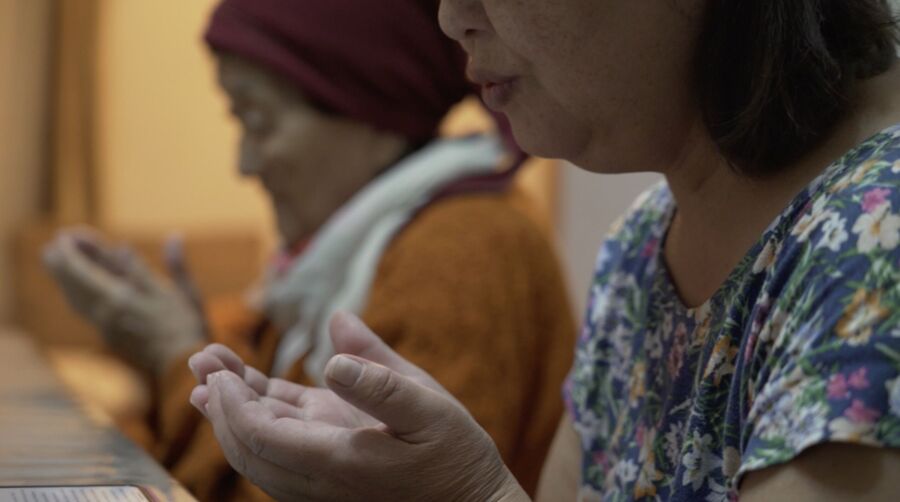
Aida Adilbek: Until I started editing the movie, I didn’t even know it would be a documentary. I had envisioned an experimental video, something static, like a video of making qurt. But when I watched all the footage, I suddenly realized that I wanted to leave all the roughness of the footage and the feeling of my observation. I liked the non-static footage better, which is a little wobbly. I’ve been told by a few movie friends that it’s a bit “off”. I, on the other hand, liked these scenes much better because they are lively, as is the whole voice cast, and the sounds that happen in the background. They were really stirring me up too, and I thought I wanted to leave it as it was.
In 2019 I started my master’s in London at Goldsmiths. I went to Almaty on my vacation. I think it happens so often that when you go away from somewhere for a long time (I was away for a year) and then come back, you see reality differently. I suddenly realized that my parents had aged. Then my grandmother came, and I realized that she had aged too. When I saw them all the time, I didn’t notice. And here, when a little time had passed for me away from them, I suddenly saw that they were ageing. They don’t last forever. And I started to have existential questions. And with the qurt, too, because my grandmother always brings me qurt. There are very few people in our family who like qurt as much as I do, so my grandmother purposely brings it to me.
I thought then that if my grandmother passed away, there would be no one else to make qurt. Not me, not my mom, not my sisters, no one. So I started recording my grandmother, following her around the house and filming her making qurt on my iPhone. None of that worked. I had a bit of a breakdown – I deleted all the files, I didn’t like them. But there was one freeze frame that I liked. It was a dark background with a very contrasting hand and a white qurt. That shot stayed in my head for a long time.
I came back to it while preparing an exhibition for Documenta with the DAVRA team. We talked to Saodat Ismailova, the creator of DAVRA, about the plans. I came back to the subject and said that I wanted to film my grandmother making qurt. She said: “Go ahead.” I borrowed a friend’s camera, told my grandmother, “When you get here, let’s make some.” She told me to buy three litres of fresh, steamed milk and prepare it so that it starts to sour. We bought it, started filming, and during the shooting I realized that this was a film about three generations of women in my family.
Kristina Mikhailova: It is absolutely impossible to imagine Aida with her warm project within the walls of “Kazakhfilm,” because the huge film studio can hardly accommodate Aida as an artist. It is also practically impossible to present Aida’s project as pitch to apply for state funding. Obviously, this situation needs to change, Aida documents our everyday life with stunning accuracy, constructing actual narratives about Kazakhstani society. But no one will allow directors and producers to spend public money on a personal movie about a grandmother. When you study documentary filmmaking, this is the first stereotype that Kazakhstani teachers will greet you with: “Make a movie about what you know! Make one about your grandmother.” In a way, this devalues any movie about a grandmother, about all the grandmothers of Kazakhstan, postulating it as something not serious, academic, amateur, and unimportant. But if every other viewer cried during screenings of “Alaqan,” why can’t we recognize that the personal and the family are the most important aspects through which we, as a society, form our subjectivity?
Read more on Novastan: Sweet Milky Corn: the film, in which everyone recognizes themselves
I work as a documentary film director and producer. They are two positions that sometimes contrast each other. For me, as an artist, it is very important that these contrasting dialogues are within myself. The next commentary I say only as a producer who thinks about the developing horizons of documentary film including market horizons. Producers and decision-makers of documentary films in Kazakhstan focus on long outdated thematic constructs. SCSNC and the Ministry of Culture and Sport of Kazakhstan announced exclusively themed open calls. These slots are a monstrous legacy. Every documentary filmmaker is obliged to fit their feelings, vague premonitions and reflections of several years of his life into these slots. This is why I sharply contrast the notion of “documentary filmmaker” and “documentary artist”. “Documentary filmmaker” fulfils one’s expectations and fits into the shoebox of meanings prepared for him. The “documentary artist” independently initiates a topic that is interesting and feasible for them in the context of producing knowledge about Kazakhstani society.
Overcoming industry constraints is not the job of the documentary artist; it is the job of the producer. The producer secures financial opportunities, incorporates the artist’s unique vision into existing structures with their limitations, and advocates for the needs of the project throughout the production and distribution stages. We refer to the production of documentary filmmakers working with decolonial narratives as decolonial production.
But decolonial production in Kazakhstan currently doesn’t exist. Kazakhstani documentary film producers either work at “Kazakhfilm” or own private studios and ateliers producing commercial content. In the airless space of open talks, my colleagues engage in deep discussions about the creative industry, sharing naively optimistic hopes. It is easy to find many master classes by Kazakhstani documentary filmmakers on how to make real documentary films. But in practice, statistically assessing the industry, we see funding opportunities only for commercial orders and for films based on a thematic plan that has been handed down from above.
It is worth taking a complete look at the reasons for this. Current film professionals for the most part have direct or indirect backgrounds only in the Russian/Soviet education system. Interaction with the international film industry/education system is only available to a limited number of people. By the term “international industry” we do not mean the “Western” industry in its negative connotation, but the Asian, American and European markets together. Institutionally, such interaction is not supported in any way by the state or private foundations.
The knowledge obtained fragmentarily is introduced into the local industry and soon dies out as alien elements.
Elementary co-production in cinema with many countries is closed for Kazakhstan because we have not signed key conventions or memorandums. Lack of education and limited alternative financing options lead to the fact that there is no producer for Aida Adilbek’s next film. In the current outlook, her cinema will either exist marginalized for a narrow audience or will eventually transform into something conformist.
As a filmmaker and artist, I take a more gentle view of this painful question. My oppressed colleagues, professionally nurtured by the shock therapy of the 1990s, the financial pre-crisis debauchery of the 2000s, and the almost criminal laws of the local film industry of today, have no time, energy, or desire for reflection and solidarization. Especially if each of us personally is in total dependence on project financing. If there is a project, there is a budget, there are salaries, there are temporary minimum social guarantees. If there is no project, the whole scheme collapses for the 30-50 people involved in making the movie.
We at “Women make docs” organize online sessions for Central Asian documentary filmmakers and producers, where we introduce representatives of major international institutions and foundations to projects from the region in order to increase funding opportunities. Filmmakers from Kazakhstan, Uzbekistan, Tajikistan, Kyrgyzstan and Turkmenistan ask the following questions: “Is there censorship in international foundations?”, “What genres do international foundations support?”, “What topics are of interest to international foundations?”.
Such questions suggest that documentary filmmakers in Central Asia think of themselves as craftsmen, fulfilling thematic and genre orders, which are censored at all stages of filmmaking, from idea to final cut.
Aida Adilbek was a participant in one of the sessions, where she asked whether international funds accept applications for hybrid films that combine several genres. The answer was positive, with the clarification that the average budget for such a film is 200-300 million tenge, while the Kazakhstani budget for documentaries is fixed between 25 and 50 million tenge.
The regional conference “Decolonization of Central Asia: Changing Narratives” organized by the Institute for War & Peace Reporting in Almaty on 15-17 March 2023 resulted in recommendation notes for civil society, governments, media and international organizations. In terms of documentary filmmaking and decolonial production, I think it is necessary to prioritize governmental-level financial support for documentary projects working in all forms and genres with the concept of Kazakhstani identity. Very personal, almost intimate documentary stories, family documentaries, archival documentaries – this is what will help ethically introduce the decolonial discourse into a broad public discussion without creating new collective trauma. Aida said in an interview about her first solo exhibition that for her, the process of decolonization is about putting ourselves at the center, producing knowledge about ourselves, taking close-up shots of ourselves. In this regard, it is noteworthy that “Alaqan” consists almost entirely of close-ups.
Aida Adilbek: For me, the close-up is, first of all, cozy. It’s a bit claustrophobic. It’s very strange. It’s a bit complicated because it doesn’t always fit everything. It’s incomprehensible, but at the same time it’s very clear to me. I think the close-ups are very sincere in the way everything works. The movie for me started with a contrasting close-up of my grandmother’s hands. And I called the movie “Alaqan” (kaz. for “palm” – editor’s note).
There are several meanings in the film title. Hands play a major role in the movie. They produce something or teach other hands to do something. I have a lot of videos on my phone of people doing something with their hands. It’s one of the most beautiful moments and the most sincere, when people are not concerned with how they look, who they are, what they are. They are completely in the process, including my mother and grandmother, who taught me different things in the movie.
Alaqan is also a two- to three-color pattern that looks like a snake. My interpretation is that this pattern is similar to the veins and arteries that are in our palms. They are yellow, green or blue, pink. During the DAVRA practices we were looking at what Ilon pari is. It is the spirit of the snake. When the snake peels off its skin, it is like a woman giving life to her daughter and passing on her most important qualities to her daughter. We are passing something very important from one woman to another from generation to generation. In fact, it’s like one woman living in different bodies for thousands of years. That was very important to me in the movie. That’s why the title somehow came together right away. “Alaqan” – these hands, this pattern that has the meaning of blood, and continuation, and palm, and everything.
My film during Documenta was a part of the project “Chilltan suv” (Uzbek. for “water of the Chiltans”) related to water. Chiltans are helper spirits that have different forms and manifestations. I wanted to think about how a woman heals the space, the people around her, the house and everything she touches through water, through milk. This is also why I included my mother’s gardening in the movie. I myself mostly have some still small domestic role, also related to water. I wash dishes.
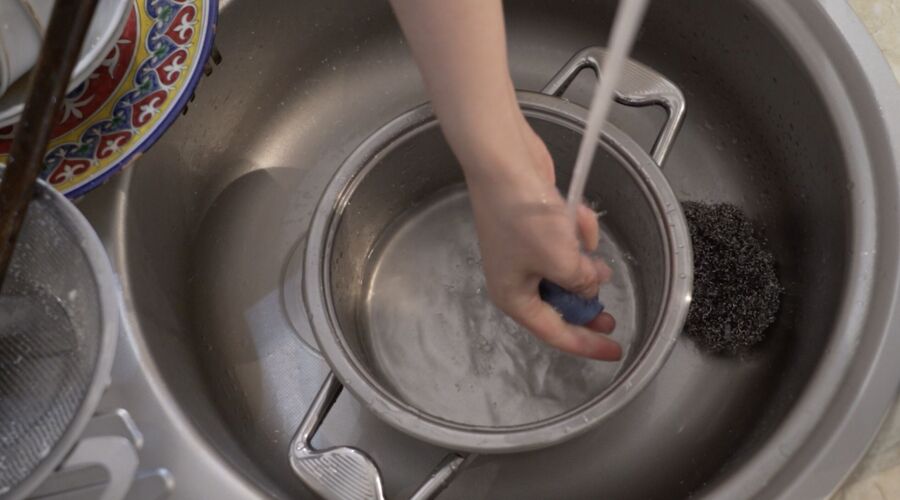
Someone told me that the rain scene in the movie was unnecessary. Of course, I don’t tell everyone the concept of the connection with water, people don’t need to know. It’s only important for me to know. I always want to leave the rain in the final cut because it doesn’t have any intellectual context.
Almira Ismailova: I think the main theme that Aida reveals to the general audience in her movie is the fear of death. She tries to adopt her grandmother’s recipe for making qurt as soon as possible, and the camerawork and the choice of angles epitomize her desire. The grandmother’s regal calmness in the face of the inexorable end is palpable. Aida’s fear is not constraining. She even seems to resign herself to it. It is a constructive fear that shortens the distance between Aida and her grandmother. It made me wonder how this came to be. The dramaturgy of the movie does not obey the precepts of American textbooks about the three-act structure, and it is difficult to pinpoint exactly who the antagonist and protagonist are, yet Aida and the grandmother seem to oppose each other. When the protagonist realizes their similarities to the one they are opposed to, the story has a new dimension. Within the universe of the movie “Alaqan,” Aida and the grandmother together stop being afraid of dying. And this therapeutic effect gives Aida the opportunity to experience the loss of a loved one in real life.
The director skillfully works with subtext, revealing the image of the grandmother through action. As the qurt is being prepared, we hear from the grandmother: “Ädemileyin degen son, söytip shigadi goy – teris qaray” (“When you want to make it more beautiful, it turns out wrong”). She is touchingly worried that it is during the filming that the qurt will not turn out right. Aida’s grandmother carefully collects the mass from her hands, which is used to make the qurt, down to the last grain. She, as a person of the generation who has had many challenges, has a very reverent attitude to food. Milk was valued by Kazakhs as something sacred: it must not be spilled on the ground or desecrated. Probably, that is why white colour symbolizes something good and pure. If they wanted to praise a person in any way, they always added the word aq (Kaz. for “white”) – aq jarqin (Kaz. for “cheerful”), aq könil (Kaz. for “good-natured”). Through the episode with the joint reading of the story about Jirenshe and the clever girl, we understand what human qualities the grandmother admires. This way of telling about the hero allows the viewer to come to conclusions and makes the relationship between the author and the viewer comfortable, not abusive.
Aida Adilbek: The most important motto of my work – not only artistic, but also curatorial – is that I do it for myself. But it is important to make exhibitions for people, so I want to make them as comfortable as possible. The hall where I showed “Alaqan” during my solo exhibition was very cozy, comfortable, with carpeting and pillows. And during Documenta, the day of my solo exhibition, I had to put on a performance. The concept consisted of three parts: a sound installation, the movie “Alaqan” and a performance. All in different halls. Visitors walk through all three halls. The three works had to be connected several times a day. The movie was played cyclically in the hall and the audio installation was turned on three times a day. The performance was called “Chilltan suv.” Chilltan figures – conventionally creatures generated by water – appeared in the hall. During that performance, I suddenly realized that these creatures were milky, like qurt. Probably, when all rivers and waters originated from Umai, they were filled with the milk of her breasts.
For more news and analysis from Central Asia, follow us on Twitter, Facebook, Telegram, Linkedin or Instagram.
This article was first published by Vlast.kz
Visual materials are provided by the “Women make docs” collective
 “Alaqan”: Aida Adilbek’s decolonial documentary cinema
“Alaqan”: Aida Adilbek’s decolonial documentary cinema 
